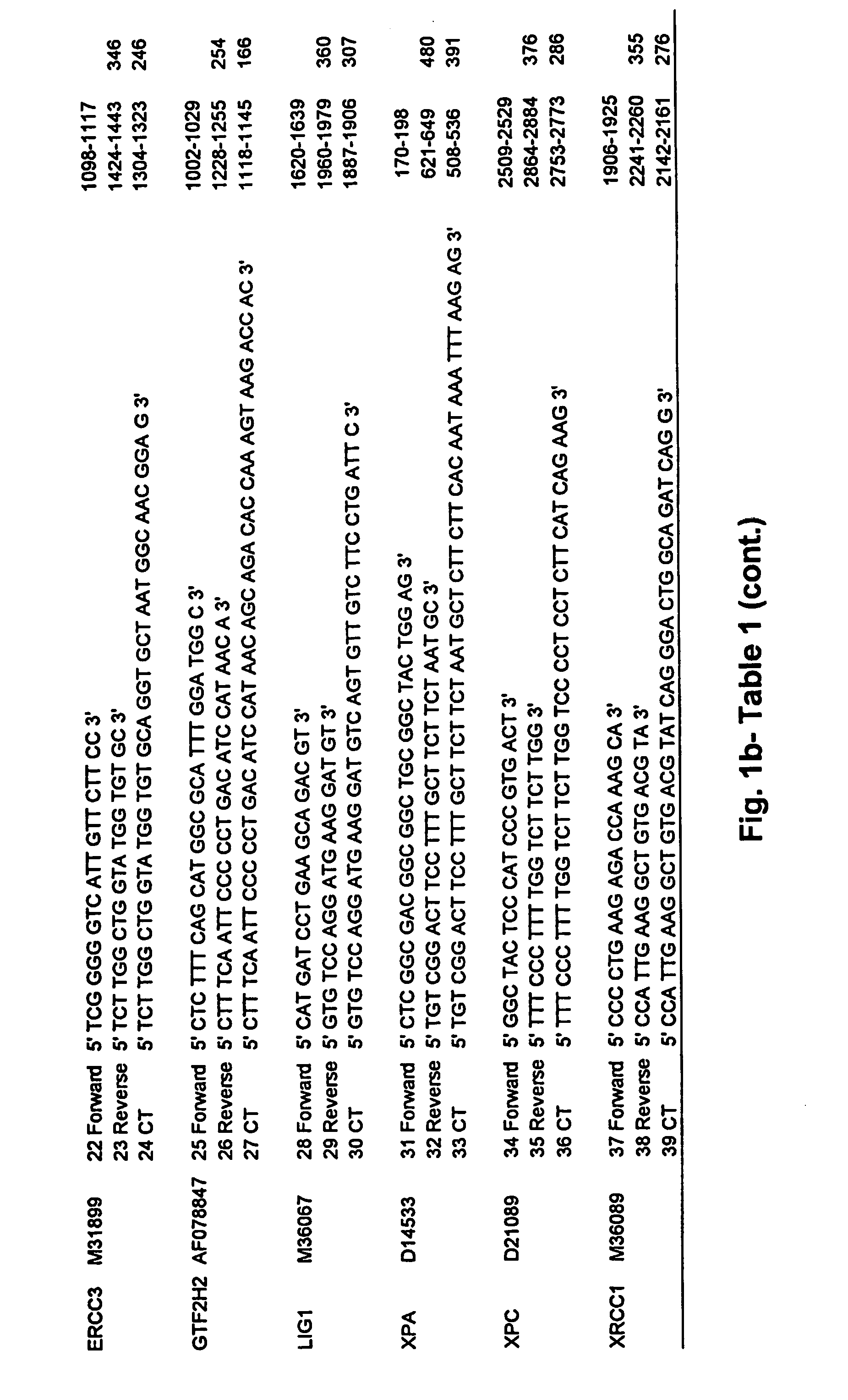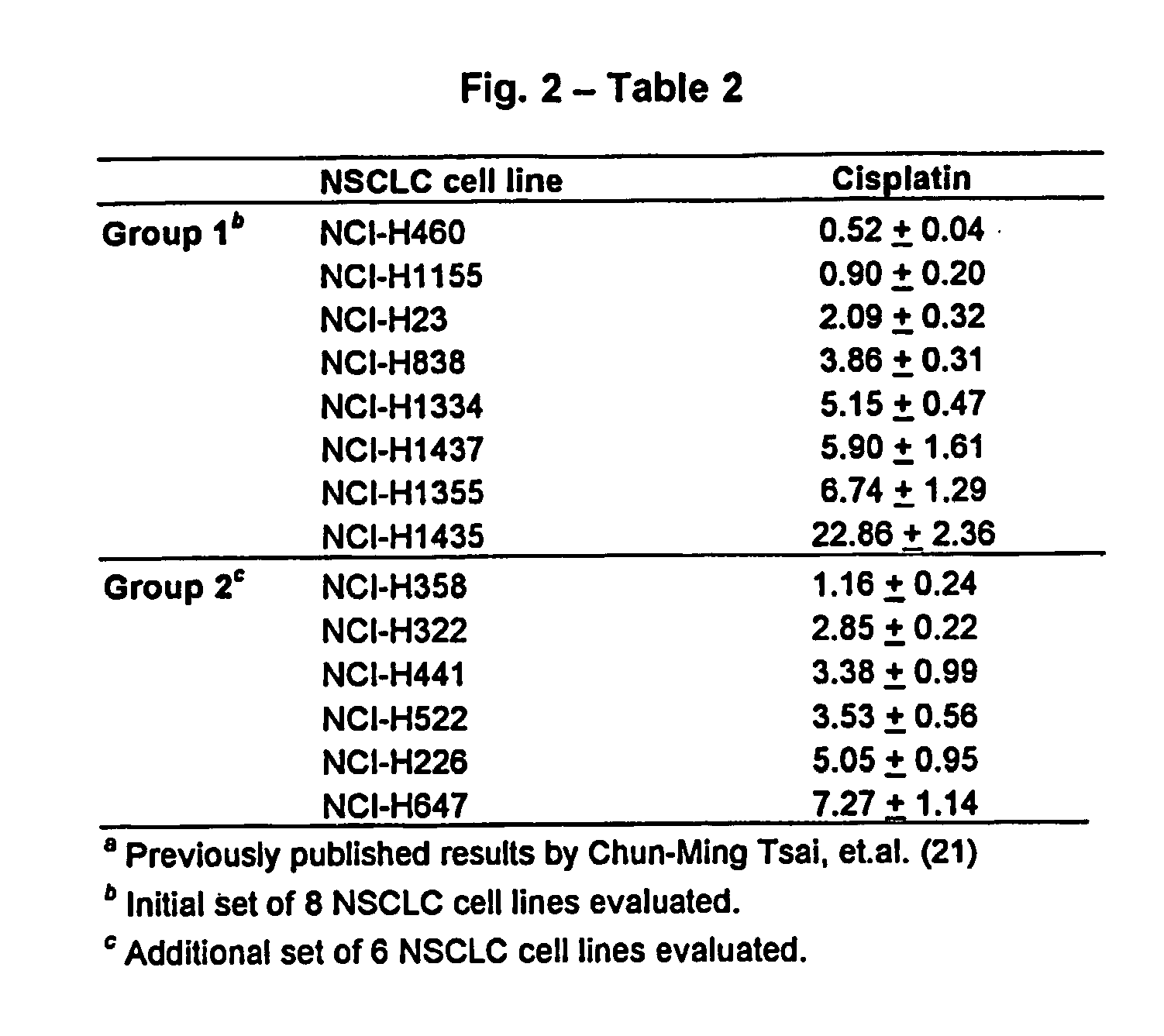Method and compositions for the diagnosis and treatment of non-small cell lung cancer using gene expression profiles
a non-small cell lung cancer and gene expression technology, applied in the direction of microbiological testing/measurement, biochemistry apparatus and processes, fertilization, etc., can solve the problems of ineffective or less effective therapeutic agents for patients, affecting the survival rate of patients, so as to achieve accurate diagnosis of lung cancer
- Summary
- Abstract
- Description
- Claims
- Application Information
AI Technical Summary
Benefits of technology
Problems solved by technology
Method used
Image
Examples
specific embodiments
[0073] The examples provided below concern the identification and quantification of markers that distinguish in cancer cell lines that are sensitive to defined chemotherapeutic agents, namely platinum compounds from those that are not responsive. Accordingly, one or more of the markers can be used to identify cancer cells that can be successfully treated by that agent. A change in the expression in one or more of the markers can also be used to identify cancer cells that cannot be successfully treated by that agent. These markers can therefore be used in methods for identifying cancers that have become or are at risk of becoming refractory to treatment with the agent.
[0074] The expression level of the identified markers may be used to: 1) determine if a cancer can be treated by an agent or combination of agents; 2) determine if a cancer is responding to treatment with an agent or combination of agents; 3) select an appropriate agent or combination of agents for treating a cancer; 4...
examples
[0185] A skilled artisan can readily recognize that there is no limit as to the structural nature of the agents of the present invention. As such, without further description, it is believed that one of ordinary skill in the art can, using the preceding description and the following illustrative examples, make and utilize the compounds of the present invention and practice the claimed methods. The following working examples therefore, specifically point out the preferred embodiments of the present invention, and are not to be construed as limiting in any way the remainder of the disclosure.
[0186] In one embodiment, standardized RT (StaRT)-PCR, was employed to assess various mutidrug resistant genes in a set of non-small cell lung cancer (NSCLC) cell lines with a previously determined range of sensitivity to cisplatin. Data were obtained in the form of target gene molecules relative to 106 β-actin (ACTB) molecules. To cancel the effect of ACTB variation among the different ells line...
example i
Materials and Methods
Cell Culture
[0188] Non-small cell lung cancer (NSLC) cell lines H460, H1155, H23, H838, H1334, H1437, H1355, H1435, H358, H322, H441, H522, H226 and H647 were obtained from the American Type Culture Collection (Rockville, Md.). All cells were incubated in RPMI-1640 medium (Biofluids, Inc., Rockville, Md.) containing 10% fetal bovine serum (FBS) and 1 mM glutamine at 37° C. in the presence of 5% CO2. Proliferative, subconfluent cultures were obtained from RNA extractions and subsequent analyses.
Reagents
[0189] 10× PCR buffer for the Rapidcycler (500 mM Tris, pH 8.3; 2.5 mg / μl BSA; 30 mM MgCl2) was obtained from Idaho Technology, Inc. (Idaho Falls, Id.). Taq polymerase (5 U / μl), oligo dT primers, RNasin (25 U / μl) and dNTPs were obtained from Promega (Madison, Wis.). M-MLV reverse transcriptase (200 U / μl) and 5× first strand buffer (250 mM Tris-HCl, pH 8.3; 375 mM KCl; 15 mM MgCl2—; 50 mM DTT) were obtained from Gibco BRL (Gaithersburg, Md.). DNA 7500 Assay k...
PUM
| Property | Measurement | Unit |
|---|---|---|
| pH | aaaaa | aaaaa |
| melting temperature | aaaaa | aaaaa |
| temperature | aaaaa | aaaaa |
Abstract
Description
Claims
Application Information
 Login to View More
Login to View More - R&D
- Intellectual Property
- Life Sciences
- Materials
- Tech Scout
- Unparalleled Data Quality
- Higher Quality Content
- 60% Fewer Hallucinations
Browse by: Latest US Patents, China's latest patents, Technical Efficacy Thesaurus, Application Domain, Technology Topic, Popular Technical Reports.
© 2025 PatSnap. All rights reserved.Legal|Privacy policy|Modern Slavery Act Transparency Statement|Sitemap|About US| Contact US: help@patsnap.com



